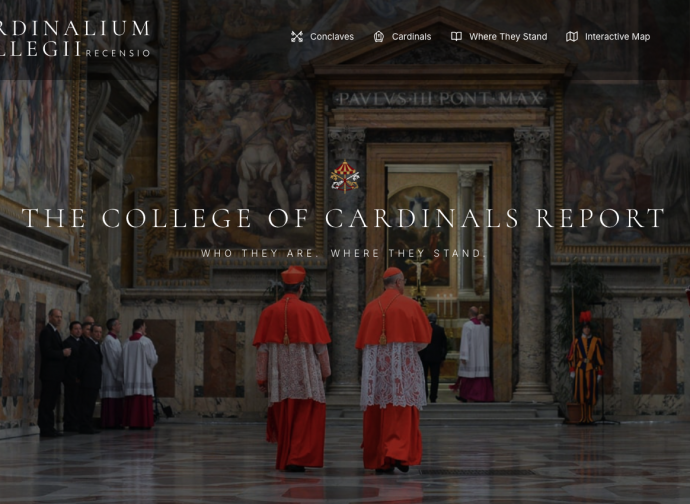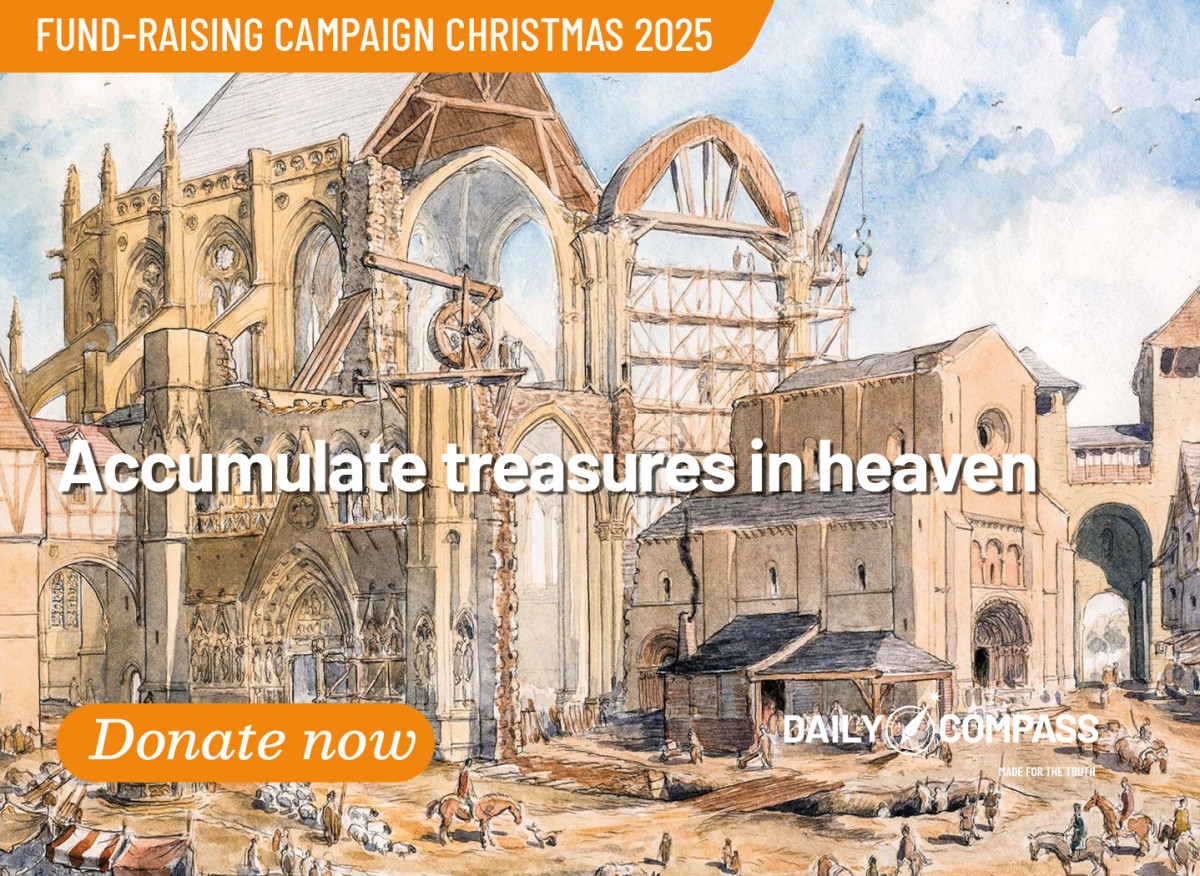Cardinals under the microscope: a website reveals what conclave candidates think
Not predictions, but thoughtful profiles: The College of Cardinals Report examines the spirituality, doctrine and governance of an ever-growing number of cardinals. The editors, Edward Pentin and Diane Montagna, also explain that the last decade has provided few opportunities for Cardinals to know each other.

Their numbers increase, but the cardinals less informed about each other: it’s a serious problem for those who will sooner or later be called upon to elect the next Pope, considering how little they know about each other (including the one who will be elected). Quite a paradox in the age of the Internet, which offers an infinite amount of information but lacks the crucial elements needed to understand the spirituality, orthodoxy (or heterodoxy!) and ability to govern of the man to whom one day they will entrust the keys of St Peter's. This gap has recently been filled by the website The College of Cardinals Report, edited by Vatican experts Edward Pentin and Diane Montagna, who tell the Daily Compass the reasons and aims of this joint project.
Edward Pentin, you are the co-founder of The College of Cardinals Report. Why create a special website dedicated to cardinals? A visitor to the site might ask: weren’t the biographies already online (on the Vatican website or elsewhere...) sufficient?
Edward Pentin: Most if not all online biographies of the cardinals, such as those the Holy See’s site, have just basic biographical information – where the cardinals were born, their academic background, and the ecclesial positions they’ve held. While this is of course useful, the reader doesn’t get much of a sense of the man and what he stands for. The College of Cardinals Report aims to address that by providing in-depth profiles of over 40 cardinals (with more planned) and over 200 summary profiles which, although brief, aim to give the reader a better idea of who a cardinal is and where he stands.
Has the need for such a site only arisen recently, with the Sacred College becoming larger and more international, or was there also an attempt in the past to bridge the gap in the cardinals’ knowledge of one another?
Edward Pentin: The need — and requests for — such a resource became especially acute post-2014 when Pope Francis halted meetings of cardinals at cardinal-making consistories, thereby removing a helpful opportunity for them to become acquainted with one another. Also, and as you note, since he was elected Pope in 2013, Francis has chosen less well-known prelates to be cardinals from “periphery” locations in the developing world. As he has appointed 110 of the 138 cardinal-electors (as of February 11, 2025), this means that many of them are unfamiliar with each other.
My 2020 book The Next Pope, which profiled 19 of the leading cardinal candidates, was a first attempt to address this, and The College of Cardinals Report is an expansion on that. But there have often been books detailing the “runners and riders” ahead of a Conclave. John Allen’s 2002 book Conclave: The Politics, Personalities and Process of the Next Papal Elections was a leader in that regard. Then, if you go back as far back as the 1550s, and possibly earlier, public notices and precursors to newspapers were posted in Rome, providing some detail on the leading candidates. These contained rudimentary details about the Princes of the Church, but they were often based on rumor, so in later centuries, diplomats and other trusted scribes would compile more in-depth and reliable biographies of the cardinals and distribute them to interested parties. Cardinal Walter Brandmüller, president emeritus of the Pontifical Committee for Historical Sciences, has said these tableau de cardinaux dated back to the 18th century. Such detailed manuscripts serve as precedents for this project.
Let’s now take a closer look at the site: Diane Montagna, as executive director and co-founder of the project you coordinated the project, the researchers and oversaw the design and creation of the website. What criteria did you both follow?
Diane Montagna: Our goal was to create a resource for the cardinals that is professional, attractive, and user-friendly. We had about 20 researchers from across the world and from different language groups. The criteria were the same as that used for The Next Pope: For the in-depth profiles, we focused on how each cardinal has fulfilled his episcopal office of sanctifying, governing, and teaching. We adhered to a methodology that aimed to show rather than tell, drawing out what they have said, taught, and how they have acted rather than eliciting journalistic opinions from others.
Another goal was to make the site interactive. A key feature we built into the site was a way for visitors to submit an amendment or addition to individual cardinal-profiles that are then vetted before being incorporated. Since the launch in December, we’ve received many helpful additions and amendments.
We also aim to launch the site in Italian. The site, therefore, is continually evolving.
Have you received any feedback from the cardinals themselves?
Diane Montagna: Yes, we have received very positive feedback from the cardinals as well as some requests for minor amendments. Our correspondence with cardinals has been very cordial and constructive.
The site includes a table (“Where They Stand”) that details certain cardinals’ positions (on celibacy, the female diaconate, blessings for homosexual couples, the traditional liturgy, the China-Vatican accord). These are not isolated aspects, but in the current ecclesial context they express a very different and even very divergent vision of the world, far beyond the normal differences in ecclesial sensibilities that have always existed. Does this herald a conclave radically divided between opposing visions of the Church?
Edward Pentin: Our aim with this feature was to provide the reader with a snapshot of where each cardinal stands on key, often neuralgic, issues of the day. I am not sure it shows the Sacred College to be any more divided than in the past, but it does highlight how many of the cardinals subscribe to views that, prior to this pontificate, were considered heterodox and therefore unacceptable.
The site does not make predictions, but it is inevitable that some cardinals (regardless of where they stand) will be more prominent than others, that they will be considered more ‘papable’. Why?
Edward Pentin: Various factors can make certain cardinals appear more prominent and therefore papabile than others. These include their influence within the Church, their theological or ideological stance, their experience in key positions (e.g., Vatican leadership, major dioceses), their visibility in the media or public perception, and their geographical background (some regions can be seen as more likely to produce a pope). We chose the list of papabili by consulting Vatican experts and others, and naturally with time the list may change and be expanded.
In the meantime, from month to month, cardinals over the age of 80 drop out of the electoral roll and new cardinals may be created. Will this site therefore be perpetually updated? Perhaps even after the election of Francis’ successor?
Diane Montagna: Yes, the site has a facility whereby cardinals who reach 80 are automatically moved to the “non-electors” category, and the site statistics and filter results are amended accordingly. However, their titles and other aspects of their profile that change because of their retirement, etc., must be manually updated. Certainly, the site is intended to be of lasting service to the Sacred College, well beyond the next conclave.
A final consideration on the topic of cardinal-electors: Does the Roman saying still hold true: “He who enters a conclave as Pope comes out a cardinal”?
Edward Pentin: Although too much talk about a candidate can tend to spoil a cardinal’s chances, the saying doesn’t always hold true: Cardinal Francesco Saverio Castiglioni was considered papabile in both the 1823 and 1829 conclaves and, although he lost support in 1823, he was successfully elected in 1829, taking the name Pius VIII. In 2005, many thought Cardinal Joseph Ratzinger would be elected pope, mainly because of his closeness to Pope St. John Paul II for so many years, but also because, as Dean of the College of Cardinals at John Paul’s funeral and his leadership the conclave, many recognized in him papal qualities.
However, it has also been the case that the Sacred College has elected a low profile candidate who was considered unlikely. Cardinal Jorge Mario Bergoglio was viewed as a strong contender in 2005 but failed to obtain enough votes. Ironically he was elected in 2013 when many thought him too old aged 76. Other surprise candidates have been Pope John XXIII (Angelo Roncalli) who was seen as a temporary pope who would “do little or no harm” and was chosen after a deadlock between two stronger candidate. Then there have been very obscure cases such as Pope Gregory X (Teobaldo Visconti) who was elected in 1271 after a nearly three-year conclave as a compromise candidate. At the time of his election, he wasn't even a cardinal.
Some have suggested that it’s distasteful to launch such a site while Pope Francis is still alive. How do you respond?
Diane Montagna: We certainly don’t think it distasteful. Only the Lord knows when the next conclave will be held, but it’s safe to say that Pope Francis is in the twilight of his pontificate and a conclave could happen at any time. During the next conclave, the window of opportunity for cardinals to get to know one another will be small. Responding to a need, we therefore wanted to create this resource now, well enough ahead of the next papal election. We obviously mean no disrespect to Pope Francis in doing so, and we pray for him and for his pontificate.
A profile of the next Pope, writes Cardinal
Two years after the text signed 'Demos' (later revealed to have been written by Cardinal Pell) a new anonymous document, linked to the first, defines the seven priorities of the next Conclave to repair the confusion and crisis created by this Pontificate.
- L'identikit del prossimo Papa (I) II "Retrato robot" del próximo Papa (ES) II L'identité du prochain pape (F) II Identität des nächsten Papstes (D) II Identyfikacja następnego papieża (PL)
Cardinal Sarah pleas like Solženicyn: "Don't give in to lies!"
Half a century after the Russian writer's famous denunciation, the African prelate echoes the same words. His warning is against the temptation to pander to the "fluid" atheism that has penetrated the Church, also in view of the next Synod.
Cardinal Pizzaballa challenges clichés on Middle East conflict
Hatred will make the post-war situation worse than the war itself. Peace? It is not even thinkable today, let's aim for a ceasefire. The two-state formula is unrealistic. We need a change of leaders to find a solution for the future. The Patriarch of Jerusalem challenges clichés about the Middle East situation.


